

Manuel de droit européen en matière des droits de l’enfant. Evaluation of legislation policy and practice of child participation in the European Union. AMBER Alert - America's Missing: Broadcast Emergency Response. Liste complète. Série des traités européens - n° 192 Convention sur les relations personnelles concernant les enfants * Strasbourg, 15.V.2003 Préambule.
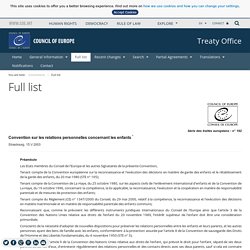
Liste complète. Home - Child Rights ConnectChild Rights Connect. L’expression et la participation du mineur, de ses parents et du jeune majeur dans le champ de la protection de l’enfance. Children's Rights. UNVIOLENCESTUDY.ORG. Connecting with the Committee - Child Rights ConnectChild Rights Connect. Useful words & phrasesChildren: Anyone under 18.Committee on the rights of the Child (the Committee): A group of 18 international children’s rights experts who check how well governments protect and respect children’s rights.Convention: Another word for ‘treaty’.NGO(Non-Governmental Organisation): A charity or group that is not part of a government.Ratify: Agreeing to do what a treaty says.Treaty: A formal agreement that a country can decide to accept.
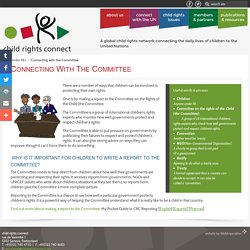
It can also be called a ‘convention’. There are a number of ways that children can be involved in protecting their own rights. One is by making a report to the Committee on the Rights of the Child (the Committee. Protection gaps risk exposing children with disabilities to abuse. Violence against children with disabilities: legislation, policies and programmes in the EU. EUROPE: Protection gaps risk exposing children with disabilities to abuse. [4 December 2015] - Boys and girls with disabilities are more likely to be victims of physical and sexual violence, and neglect, than those without disabilities.
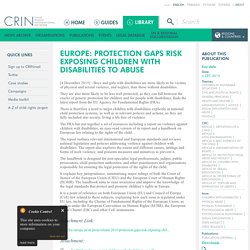
They are also more likely to be less well protected, as they can fall between the cracks of generic protection for children and for people with disabilities, finds the latest report from the EU Agency for Fundamental Rights (FRA). There is therefore a need to target children with disabilities explicitly in national child protection systems, as well as in relevant policies and actions, so they are fully included into society, living a life free of violence.
The FRA has put together a set of resources including a report on violence against children with disabilities, an easy-read version of its report and a handbook on European law relating to the rights of the child. It explains key jurisprudence, summarising major rulings of both the Court of Justice of the European Union (CJEU) and the European Court of Human Rights (ECtHR). Access to justice: challenging violations of children's rights. ACCESS TO JUSTICE FOR CHILDREN: Country reports. CRIN, with partners, has carried out a collaborative project seeking to establish how children can access the justice system in their countries.
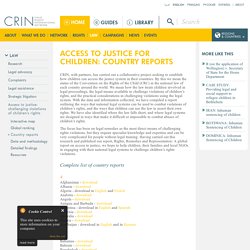
By this we mean the status of the Convention on the Rights of the Child (CRC) in the national law of each country around the world. We mean how the law treats children involved in legal proceedings, the legal means available to challenge violations of children’s rights, and the practical considerations in challenging violations using the legal system. With the data and information collected, we have compiled a report outlining the ways that national legal systems can be used to combat violations of children’s rights, and the ways that children can use the law to assert their own rights. We have also identified where the law falls short, and where legal systems are designed in ways that make it difficult or impossible to combat abuses of children’s rights.
LUXEMBOURG: Access to justice for children. This report is part of CRIN's access to justice for children project, looking at the status of the Convention on the Rights of the Child (CRC) in national law, the status of children involved in legal proceedings, the legal means to challenge violations of children’s rights and the practical considerations involved in challenging violations.
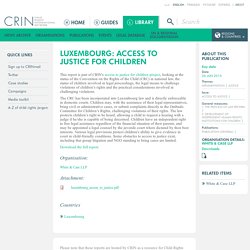
The CRC has been incorporated into Luxembourg law and is directly enforceable in domestic courts. Children may, with the assistance of their legal representatives, bring civil or administrative cases, or submit complaints directly to the Ombuds-Committee for Children’s Rights, challenging violations of their rights. The law protects children’s right to be heard, allowing a child to request a hearing with a judge if he/she is capable of being discerned. Download the full report. Promotional Image: Please note that these reports are hosted by CRIN as a resource for Child Rights campaigners, researchers and other interested parties. Child-Friendly Justice and Children's Rights. Summary: Report on children's right to child-friendly justice, including examples of good practice, international and regional standards, and research and other resources.
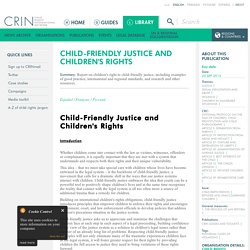
Español / Français / Русский Whether children come into contact with the law as victims, witnesses, offenders or complainants, it is equally important that they are met with a system that understands and respects both their rights and their unique vulnerability. This idea – that we must take special care with children whose lives have become entwined in the legal system – is the backbone of child-friendly justice, a movement that calls for a dramatic shift in the ways that our justice systems interact with children. Child-friendly justice embraces the idea that courts can be a powerful tool to positively shape children's lives and at the same time recognises the reality that contact with the legal system is all too often more a source of additional trauma than a remedy for children. You can download the full report here. Droits, remèdes et représentation : un rapport sur l'accès des enfants à la justice dans le monde.
L'accès à la justice est un droit humain, mais c'est également ce qui fait des autres droits une réalité.
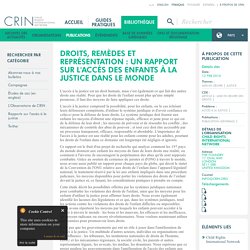
Pour que les droits de l'enfant soient plus qu'une simple promesse, il faut des moyens de faire appliquer ces droits. Rights, Remedies and Representation: A global report on access to justice for children. Access to justice is a human right, but it is also what makes other rights a reality.
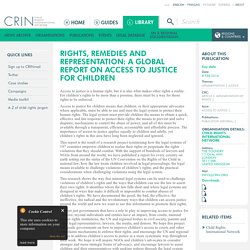
For children’s rights to be more than a promise, there must be a way for those rights to be enforced. Access to justice for children means that children, or their appropriate advocates where applicable, must be able to use and trust the legal system to protect their human rights. The legal system must provide children the means to obtain a quick, effective and fair response to protect their rights; the means to prevent and solve disputes; mechanisms to control the abuse of power; and all of this must be available through a transparent, efficient, accountable and affordable process.
The importance of access to justice applies equally to children and adults, yet children’s rights in this area have long been neglected and ignored. Access to justice should be at the core of guaranteeing children’s rights around the world. Guide sur l'assistance juridique. Eurochild. Welcome to EUROCHILD - Eurochild. CHI - Child Helpline International. Evaluation de la gouvernance de la protection de l’enfance (MAP) LOI n° 2016-297 du 14 mars 2016 relative à la protection de l'enfant.
Famille : protection de l'enfant. Travaux des commissions - commission des affaires sociales La Commission saisie au fond a nommé Mme Michelle Meunier rapporteure le 5 novembre 2014 Rapport n° 146 déposé le 3 décembre 2014 : Texte de la commission n° 147 (2014-2015) déposé le 3 décembre 2014 - commission des lois La Commission saisie pour avis a nommé M.
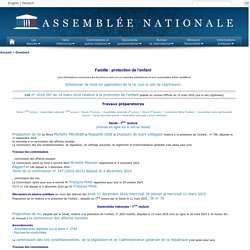
François Pillet rapporteur pour avis le 29 octobre 2014 Avis n° 139 déposé le 2 décembre 2014 par M. François Pillet. Convention on the Rights of the Child. Text in PDF Format Adopted and opened for signature, ratification and accession by General Assembly resolution 44/25 of 20 November 1989 entry into force 2 September 1990, in accordance with article 49 Preamble The States Parties to the present Convention,
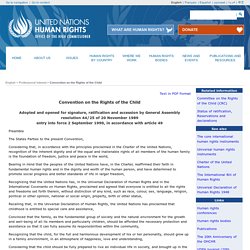
Observatoire sur la migration de mineurs. Rapport MINAS - Dans l'intérêt supérieur de qui ? - InfoMIE.net. Source : www.omm.hypotheses.org Auteurs : Corentin Bailleul et Daniel Senovilla Hernández Date : Juin 2016 1. Le projet européen MINAS2. Welcome to CRIN. Observatoire National de la Protection de l'Enfance. GIPED - Groupement d'Intérêt Public Enfance en Danger. Observatoire National de la Protection de l'Enfance. Ministère de la Justice - Alerte-enlèvement : Diffuser sur Facebook. Inégalités entre les enfants : la France 28e sur 35 pays riches. Pays riches : les 10% d’enfants les plus pauvres de plus en plus laissés pour compte. Paris / Genève / New York, 14 avril 2016 – Le Bilan 13, Equité entre les enfants : Tableau de classement des inégalités de bien-être des enfants dans les pays riches, établit le classement de 41 pays de l’UE et de l’OCDE et cherche à savoir jusqu’où les sociétés riches laissent se creuser le fossé entre les 10% d’enfants les plus pauvres et les enfants qui se situent dans la partie médiane de la distribution.
Le rapport s’intéresse aux inégalités sur 4 angles : en matière de revenus, d’éducation, de santé et de satisfaction dans la vie et à partir de données recueillies entre 2002 et 2014. Le Danemark est en tête du classement général avec l’inégalité la plus faible entre les enfants. Israël et la Turquie occupent les dernières places du classement. Revenus : Dans 19 pays sur les 41 de ce classement, plus de 10% des enfants vivent dans la pauvreté, c’est-à-dire dans des foyers avec moins de la moitié du revenu médian.
Résultats pour la France. Bien-être des enfants dans les pays riches : résultats 2016, trop d’inégalités !
Maltraitance. ChildrEn. Médiation. 119. 116 000 Enfants Disparus. ChildLine.